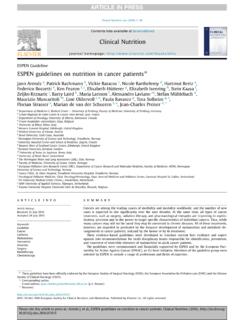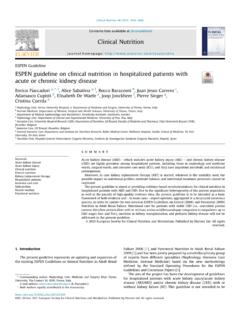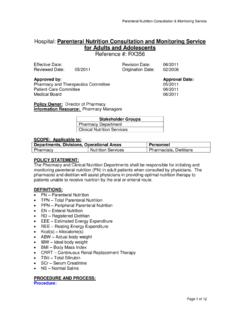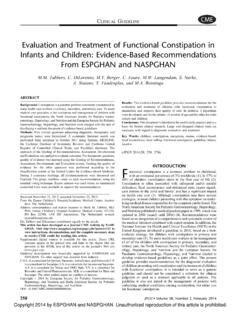Transcription of ESPEN endorsed recommendations: Nutritional therapy in ...
1 ESPEN endorsed recommendations : Nutritional therapy in majorburnsqAnne-Fran oise Rousseaua, Marie-Reine Losserb, Carole Ichaic, Mette M. Bergerd,*aBurn Centre and General Intensive Care Department, University Hospital, Li ge, BelgiumbIntensive Care Department, University Hospital, Nancy, FrancecMedical and Surgical Intensive Care Unit, Saint-Roch Hospital, University of Medicine of Nice, Nice, FrancedService of Adult Intensive Care Medicine and Burns Centre, University Hospital (CHUV), Lausanne, SwitzerlandqExpert group of the Soci t Fran aise d Anesth sie-R animation (SFAR), Soci t Francophone de Nutrition Clinique (SFNEP),Soci t de R animation de langue Fran aise (SRLF).article infoArticle history:Received 21 January 2013 Accepted 17 February 2013 Keywords:Burn injuryCritical careEvidence-basedGlucoseSubstratesHyper metabolismsummaryBackground & aims:Nutrition therapy is a cornerstone of burn care from the early resuscitation phase untilthe end of rehabilitation.
2 While several aspects of nutrition therapy are similar in major burns and othercritical care conditions, the patho-physiology of burn injury with its major endocrine, inflammatory, meta-bolic and immune alterations requires some specific Nutritional present textdeveloped bythe French speaking societies, is updated to provide evidenced-based recommendations for clinical :A group of burn specialists used the GRADE methodology (Grade of Recommendation,Assessment, Development and Evaluation) to evaluate human burn clinical trials between 1979 and resulting recommendations , strong suggestions or suggestions were then rated by the non-burnspecialized experts according to their agreement (strong, moderate or weak).Results:Eight major recommendations were made.
3 Strong recommendations were made regarding, 1)early enteral feeding, 2) the elevated protein requirements ( g/kg in adults, 3 g/kg in children), 3)the limitation of glucose delivery to a maximum of 55% of energy and 5 mg/kg/h associated withmoderate blood glucose (target 8 mmol/l) control by means of continuous infusion, 4) to associatedtrace element and vitamin substitution early on, and 5) to use non- Nutritional strategies to attenuatehypermetabolism by pharmacological (propranolol, oxandrolone) and physical tools (early surgery andthermo-neutral room) during thefirst weeks after injury. Suggestion were made in absence of indirectcalorimetry, to use of the Toronto equation (Schoffield in children) for energy requirement determination(risk of overfeeding), and to maintain fat administration 30% of total energy :The Nutritional therapy in major burns has evidence-based specificities that contribute toimprove clinical outcome.
4 2013 Elsevier Ltd and European Society for Clinical Nutrition and IntroductionSevere burn injuries remain a major health care problemthrough the World. There are good news though: thefirst is that thevast majority of injuries are small bagatelle injuries that can betreated as outpatient, with a little less than 10% of the victimsrequiring hospital admission, and only a few requiring intensivecare (ICU) treatment1,2; the second is that burn care has improvedtremendously over the last 3 decades, resulting in a reduction ofboth mortality and of sequelae. Major burn injuries, thoseaffecting more than 20% total burn surface area (TBSA) with orwithout inhalation injury, represent a specific condition whencompared to the general intensive care pathologies.
5 Critically illburned patients are characterized by a strong oxidative stress, anintense inflammatory response, and a prolonged months-long hy-permetabolic and catabolic response, all of which are proportionalto the severity of injury (depth and extent). Nutrition therapyconstitutes an integral part of the treatment, from the early start ofthe initial resuscitation.*Corresponding author. Service of Adult Intensive Care Medicine and BurnsCentre, CHUV , Rue du Bugnon 46, CHe1011 Lausanne, : 41 21 314 2095; fax: 41 21 314 Berger).Contents lists available atSciVerse ScienceDirectClinical Nutritionjournal homepage: $esee front matter 2013 Elsevier Ltd and European Society for Clinical Nutrition and Nutrition 32 (2013) 497e502 The body of literature concerning burns nutrition has increasedover the 3 last decades, while some important trials should becompleted during 2013.
6 The American Burn Association (ABA)published guidelines for the management of burn injuries in 2001,3based on a Medline search including years 1966 through many aspects of management have evolved since that date, andparticularly those concerning energy requirements, the Frenchspeaking societies included a revision of Nutritional therapy inmajor burns in their upcoming global nutrition Material and methodsExperts in charge of burns nutrition were nominated based ontheir experience by delegates of three scientific societies: Soci t Fran aise d Anesth sie-R animation (SFAR), Soci t de R an-imation de Langue Fran aise (SRLF) and Soci t Francophone deNutrition Clinique et M tabolisme (SFNEP).Based on a PUBMED search including human studies 1979through 2011, the experts produced a review of the literature andelaborated a French version of recommendations using the GRADE methodology (Grade of Recommendation, Assessment, Develop-ment and Evaluation),4that was validated by the widened non-burn specialized expert group.
7 This method takes into accountthe quality of evidence study limitations, inconsistency of results,indirectness of evidence, Imprecision, reporting bias, the balancebetween benefits versus harms, and endpoint quality of evidence of each study used to support the rec-ommendations was systematically specified ( the supplemental on-line Tableprovides the list of the studies included in the analysis).The global evidence quality was therefore up- or down-modulatedby the weight of these three additional factors. Each recommen-dation was thus allocated afinal level of evidence which deter-mined its wording: we recommend (or we do not recommend )for a strong recommendation, we strongly suggest (or westrongly do not suggest ) for a moderate recommendation, wesuggest (or we do not suggest ) for a weak recommendation.
8 Eachrecommendation was then rated by all experts on a scale from 1 to9(1 disagreement, 9 agreement). A median score was calcu-lated (after exclusion of the highest or lowest ratings, if necessary)that could fall into one of 3 zones: [1e3] disagreement; [4e6] indecision; [7e9] agreement. If the confidence interval ofthe median was within thefirst or last zone, the strength of therecommendation was considered to be weak or strong, respec-tively. With this methodology, strength of recommendation has tobe distinguished from the level of agreement (or disagreement)obtained from the vote of the experts: for example, it is possible topropose a weak recommendation with a strong agreement, orinversely a strong recommendation with weak agreement ( forthe use of rhGH in children).
9 3. RecommendationsMajor burn patients arefirst of all critically ill. By default gen-eral ICU recommendations apply. Many high quality humanstudies, randomized and placebo controlled with reasonablenumber of patients, were published during the period, investi-gating major burn specific issues, enabling a reasonable GRADE rating (Table 1). Route of feedingThe gastrointestinal tract is particularly at risk during the earlyburn resuscitation phase due to the major stress resulting fromburn injuries and from the treatment required to maintain life. As aresult of the early massive capillary leak causing an hypovolemicshock, large amounts of crystalloids are required during thefirst24e4 8 h to maintain blood pressure.
10 Thefluid resuscitation causesgeneralized edema, including in the gut, contributing to thedevelopment of a paralytic ileus in case the gastrointestinal tract isnot used early on. Intestinal permeability is also significantlyincreased shortly after injury compared to other ICU early enteral feeding, initiated within thefirst 6e12 h af-ter injury by the gastric route is associated with numerous clinicaland biological advantages, such as attenuation of the stress hor-mone levels, of the hypermetabolic response,6results in increasedimmunoglobulin production,7reduction of stress ulcers, whilereducing the risk of malnutrition and of energy ,9 The gastric route should be attemptedfirst, keeping the post-pyloric access option or even percutaneous endoscopic gastro-stomy (PEG)













